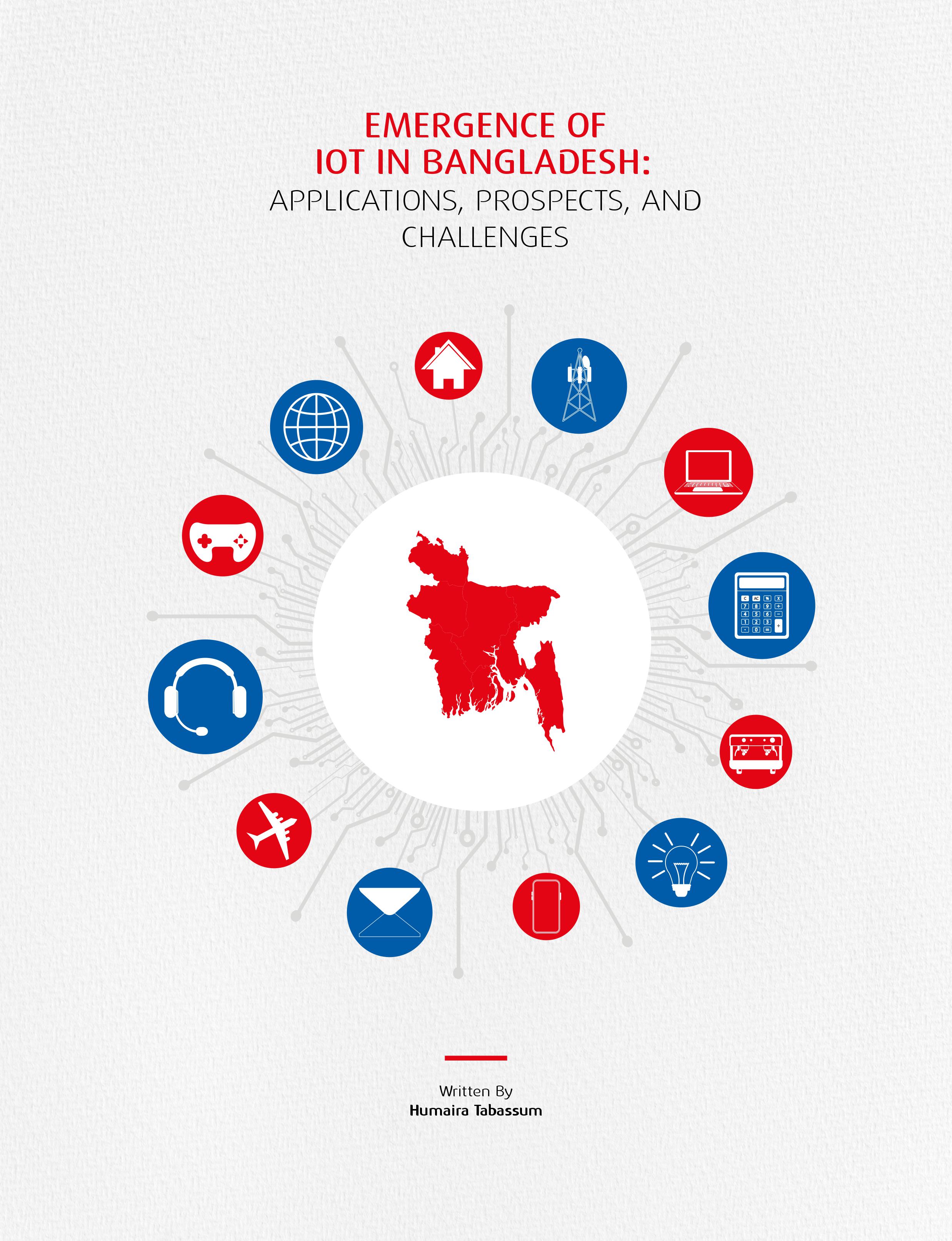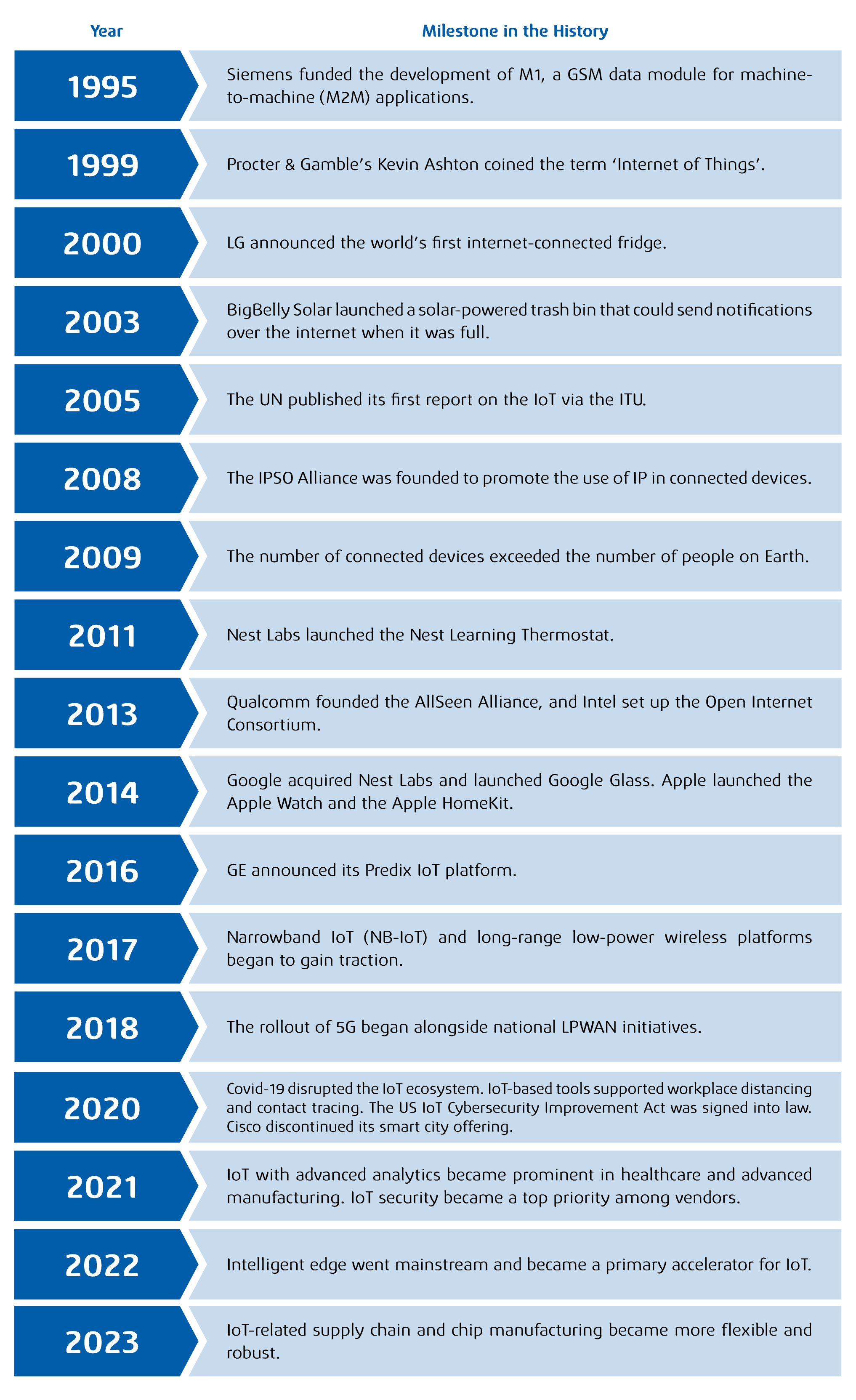
Emergence of IoT in Bangladesh: Applications, Prospects, and Challenges
Humaira Tabassum
The integration of the Internet of Things (IoT) into business operations represents a transformative shift in how companies operate, innovate, and compete. The IoT connects several sensors, devices, and systems that used to operate in isolation. Combined with the internet, these components can offer various benefits to businesses, such as increased efficiency and the development of fundamentally new services. IoT presents opportunities for businesses to capture more value and expand the scale of their operations in order to stand out against the competition. By enabling devices to communicate and interact seamlessly over the internet, IoT provides businesses with unprecedented opportunities for automation, data collection, and real-time analytics.
The number of IoT connections worldwide is expected to double from about 15.90 billion in 2023 to 32.10 billion in 2030, according to Statista. China will have the largest number of IoT devices by 2033, which amounts to almost 8 billion consumer devices. IoT devices are used across all industries, and the consumer segment will account for approximately 60% of the use of IoT devices in 2023. This proportion is anticipated to remain at the same level for the next ten years.
A Brief History of the IoT
According to Global Defence Technology, the IoT came into being between 2008 and 2009, marking the point when the number of connected devices surpassed the global human population. While IoT-related concepts have been in development for many years, 2009 is often cited as a significant milestone. Today, billions of devices such as cars, refrigerators, speakers, watches, and heart monitors leverage IoT.
The table below outlines the key milestones in the history of the IoT.

Source: Global Defence Technology
Emergence of IoT in Bangladesh
The advent of IoT in the context of Bangladesh played an important role in the technological transformation of the country. It has fostered innovation on many fronts, gearing the transition towards digitalization across different fields. Though Bangladesh has started utilising IoT comparatively late in contrast to many other countries, its adoption is stepping up very quickly in recent years owing to the growing awareness of the country’s authorities regarding the opportunities IoT can offer to address existing problems. The Bangladesh Telecommunication Regulatory Commission (BTRC) has indeed played a crucial role by legalising IoT in 2018 to explore versatile sectors including smart building, industry automation, smart grids, water management, waste management, smart agriculture, telecare, intelligent transport systems, environment management, smart urban lighting, and smart parking.
The government’s a2i programme is highly proactive in promoting the usage of IoT in the agriculture sector. a2i has proposed an IoT-enabled livestock management system where a wearable collar or tag can be used to monitor the location, temperature, blood pressure, and heart rate of animals and wirelessly send the data to farmers’ devices with the help of battery-powered sensors. IoT-enabled soil condition monitoring for crop farming and IoT-enabled water quality monitoring for fish farming have also been proposed.
In the private sector, Bondstein offers real-time monitoring of harsh acceleration, harsh braking, rough cornering, lane changes, excessive honking, seatbelt tracking, and so on under its flagship solution, DriveMark. Bondstein also offers a remote power generator monitoring solution that provides load analytics, voltage parameters, and current flow status to the users.
Robi has been offering 24 types of IoT-related products and services since September 2020. Robi has introduced an IoT-based smart factory management solution for the country's RMG sector in association with nCinga, a start-up company based in Singapore. Grameenphone has introduced an IoT product line with the dedicated app ‘Alo’. Banglalink offers an IoT-based vehicle tracking solution.
Challenges
While IoT appears to provide us access to the promised digital world, it also faces several challenges to unlocking its full potential in the country.
Secure and uninterrupted internet connectivity is a prerequisite for deploying IoT systems or devices. High-speed, uninterrupted internet connectivity needs to be available in all parts of the country outside the metropolitan cities.
One of the functional imperative challenges that the country is facing is a lack of technologically skilled personnel. Bangladesh does not have sufficient experience in the field of IoT. However, there are some efforts to train personnel on IoT by various institutions, such as BRAC University and Grameenphone, in collaboration with the Institute of Electrical and Electronics Engineers, Datasoft, Bangladesh Skill Development Institute, Global Skills Development Agency, etc.
The lack of availability of IoT devices and their compatible services poses challenges too. Smart home services are built based on IoT. Home assistants such as Google Home, Alexa, etc. are not fully operational in the country. Furthermore, there is a lack of IoT-enabled appliances like lights, speakers, locks, thermostats, and sensors to install smart home systems in Bangladesh. Nevertheless, limited numbers of electronic retail shops currently sell smart lights and locks, most originating from China, although they are relatively pricey to customers.
Forward Outlook
To advance the concepts of IoT for improved lifestyles in Bangladesh, the country needs to address the hurdles that are tied to the usage of IoT solutions. This involves educating the top management personnel, whether in the public or private domain, and fostering sufficient partnerships between industry and academia to equip the workforce with technological advancements.
The Internet of Things is revolutionising the business world by offering unprecedented opportunities for innovation, efficiency, and customer engagement. This technological evolution is driving significant changes across various industries, allowing businesses to harness the power of connected devices to streamline operations, reduce costs, and enhance product offerings. The adoption of IoT enables real-time data collection and analysis, which is crucial for informed decision-making and predictive maintenance, leading to increased operational efficiency and reduced downtime.
One of the most profound impacts of the IoT is its ability to transform customer experiences. By leveraging IoT technologies, businesses can offer more personalised and responsive services, enhancing customer satisfaction and loyalty. For instance, in retail, IoT can be used to track inventory in real-time, personalise marketing efforts based on consumer behaviour, and improve supply chain transparency. In healthcare, IoT devices enable continuous patient monitoring, which can lead to better patient outcomes and more efficient healthcare delivery.
Despite its transformative potential, IoT adoption is not without challenges. Security remains a significant concern, as the proliferation of connected devices increases the risk of cyberattacks. Ensuring robust encryption, regular updates, and secure default settings is essential to protecting sensitive data and maintaining trust. Additionally, the lack of standardisation across IoT devices and platforms can hinder interoperability and integration efforts, posing another barrier to widespread adoption.
Looking ahead, the prospects for the IoT in business are exceptionally bright. As technological advancements continue and businesses increasingly recognise the value of connected solutions, the adoption of IoT is expected to accelerate. This will pave the way for a smarter, more connected future where businesses can achieve new levels of productivity and value. By addressing the challenges and embracing the opportunities presented by IoT, businesses can unlock significant competitive advantages and drive sustained growth in an ever-evolving digital landscape.

Empowering the SMEs: The Instrumental Role of Lenders in Bridging the Financing Gap
In Bangladesh, small and medium-sized enterprises (SMEs) contribute only 25% of the country's GDP. However, this sector represents more than 90 percent of total business entities in Bangladesh and generates employment for 24.50 million people. According to a World Bank estimate, there is a USD 2.8 billion financing gap in this sector in Bangladesh, which is a major impediment to the country's growth potential.
Banks and other financial institutions have an enormous opportunity to offer innovative financial products and services to SMEs. However, there are several critical factors that are working as deterrents to SME financing: lack of collateral, lack of authenticity of financial data, informal borrowing, absence of documentation, narrow market access, and lower shock absorption capacity of the SMEs.
In the challenging terrain of SME financing, innovative initiatives such as the introduction of electronic KYC, providing transaction-based financing, and the adoption of financial technologies are crucial. Moreover, fostering a collaborative and responsive lending ecosystem is essential for unlocking the full potential of Bangladesh's SME landscape. By catering to the specific financing needs of SMEs, lenders can unlock new avenues for growth, innovation, and employment generation, ultimately contributing to the country's economic prosperity and social well-being.
Md. Shah Jalal
Editor
IDLC Monthly Business Review
Download View